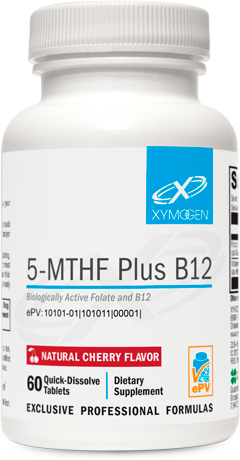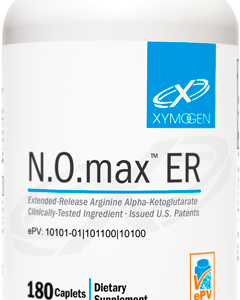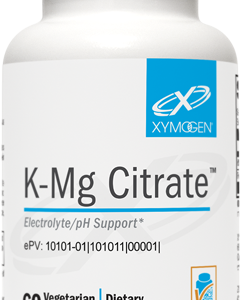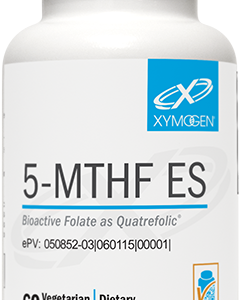Scientific Information/Data
5-MTHF (5-methyltetrahydrofolate)
5-MTHF is the most biologically active form of folate. It is the predominant type of folate present in food and the form into which the body must convert all other forms of folate.[1] Along with vitamin B12, folate serves as a donor of methyl groups. The body utilizes methyl groups in many nervous system and metabolic processes, including the conversion of homocysteine to methionine, the synthesis of monoamine neurotransmitters, the production of melatonin, and the synthesis of DNA. In addition, suf cient folate is necessary for brain and nervous system functions and for a healthy pregnancy outcome.*
5-MTHF—Preferred Over Folic Acid
Folic acid is the synthetic form of folate that is used to fortify foods. It is often found in dietary supplements as well. Despite some research showing that folic acid and 5-MTHF have equivalent bioavailability, 5-MTHF is often the preferred form to replenish folate. This is due, primarily, to the presence of digestive or metabolic variabilities that can affect the conversion of folic acid to 5-MTHF.[2 4] Furthermore, studies have shown that 5-MTHF increased plasma folate more effectively than folic acid irrespective of genetic differences in metabolism.[1,5] A study in women of childbearing age showed that 5-MTHF was more effective than folic acid in improving overall folate status.*[6]
Using 5-MTHF instead of folic acid has several important advantages. 5-MTHF provides the biologically active form of folate, reduces the potential for masking hematological symptoms of vitamin B12 deficiency, reduces interactions with drugs that inhibit dihydrofolate reductase, overcomes folate metabolism challenges associated with functioning of methylenetetrahydrofolate reductase (MTHFR), and prevents the potential negative effects of UMFA in the peripheral circulation.*[7]
Quatrefolic®
In XYMOGEN’s formulas, 5-MTHF is provided as Quatrefolic—the glucosamine salt of 5-MTHF. Quatrefolic is proven to have greater stability, solubility, and bioavailability over the commonly used calcium salt form of 5-MTHF. In a randomized crossover study, subjects received 400 mcg/d of Quatrefolic or 5-MTHF calcium salt. Titer- normalized Cmax and AUC demonstrated a 10% higher bioavailability of Quatrefolic.[8] Quatrefolic has several in vitro and in vivo preclinical and clinical studies to characterize and assure the safety pro le of the product.*[9]
5-MTHF Plus B12
XYMOGEN’s 5-MTHF Plus B12 formula combines Quatrefolic and vitamin B12 as MecobalActiveTM in cherry- avored, quick-dissolve tablets. MecobalActive is a pure form of methylcobalamin. Many vitamin B12 supplements on the market contain cyanocobalamin. The liver is able to convert a small amount of cyanocobalamin to methylcobalamin; however, methylcobalamin is the preferred form because it is the bioactive form and is therefore better utilized.[10] Another point of interest regarding B12 supplementation is the commonly held belief that intramuscular injections of B12 are more effective than oral supplementation. In fact, oral supplementation is just as effective and carries the added benefits of lower cost and ease of administration.[11,12] Unlike other sources of methylcobalamin on the market, MecobalActive does not use any harmful solvents during its manufacture. The patented, advanced production methods used to create MecobalActive also result in a methylcobalamin with greater purity and lower moisture, which translates to greater stability.*
Functions of B12
Vitamin B12 supports healthy methylation through its roles in the synthesis of methionine from homocysteine and synthesis of S-adenosylmethionine (SAMe). As an example of its importance in homocysteine metabolism, one study showed that the addition of B12 to a folate regimen had a greater impact (7%) on homocysteine than did folate alone.[13] Like folate, erythroblasts require vitamin B12 for proliferation during their differentiation.[14] B12 is important for neurological health, and chronic insufficiency can affect the spinal cord, peripheral nerves, the optic nerve, and the brain. Research also supports a role for methylcobalamin supplementation in modulating melatonin secretion, enhancing light sensitivity, normalizing circadian rhythms, and improving sleep-wake cycles.*[15,16]
*These statements have not been evaluated by the Food and Drug Administration. This product is not intended to diagnose, treat, cure, or prevent any disease.
References
1. Prinz-Langenohl R, Brämswig S, Tobolski O, et al. [6S]-5- methyltetrahydrofolate increases plasma folate more effectively than folic acid in women with the homozygous or wild-type 677C–>T polymorphism of methylenetetrahydrofolate reductase. Br J Pharmacol. 2009 Dec;158(8):2014- 21.[PMID: 19917061]
2. Yakut M, Ustün Y, Kabaçam G, et al. Serum vitamin B12 and folate status in patients with inflammatory bowel diseases. Eur J Intern Med. 2010 Aug;21(4):320-23. [PMID: 20603044]
3. Venn BJ, Green TJ, Moser R, et al. Comparison of the effect of low-dose supplementation with L-5-methyltetrahydrofolate or folic acid on plasma homocysteine: a randomized placebo-controlled study. Am J Clin Nutr. 2003 Mar;77(3):658-62. [PMID: 12600857]
4. 5-methyltetrahydrofolate. Monograph. Altern Med Rev. 2006 Dec;11(4):330-37. [PMID: 17176169]
5. Willems FF, Boers GH, Blom HJ, et al. Pharmacokinetic study on the utilisation of 5-methyltetrahydrofolate and folic acid in patients with coronary artery disease. Br J Pharmacol. 2004 Mar;141(5):825-30. [PMID: 14769778]
6. Lamers Y, Prinz-Langenohl R, Brämswig S, et al. Red blood cell folate concentrations increase more after supplementation with [6S]-5- methyltetrahydrofolate than with folic acid in women of childbearing age. Am J Clin Nutr. 2006 Jul;84(1):156-61. [PMID: 16825690]
7. Scaglione F, Panzavolta G. Folate, folic acid and 5-methyltetrahydrofolate are not the same thing. Xenobiotica. 2014 May;44(5):480-8. [PMID: 24494987]
8. Crossover Comparative Bioavailability Study of 5-Methyltetrahydrofolate Glucosamine Salt (GN10G) Compared to the Reference Metafolin® in Healthy Volunteers. IPAS-5MTHFA-583-09 final report. Desio, Italy: Gnosis S.p.A.; March
15, 2010: 1-33. [available from the manufacturer Gnosis S.p.A. upon request]
9. Thomas J, Heimbach, J, Soni M. Determination of the Generally Recognized as Safe (GRAS) Status of (6S)-5-Methyltetrahydrofolic acid Glucosamine Salt. Expert panel statement. Desio, Italy: Gnosis S.p.A.; July, 2010: 1-46. [available from the manufacturer Gnosis S.p.A. upon request]
10. Methylcobalamin. Altern Med Rev. 1998 Dec;3(6):461-3. Erratum in: Altern Med Rev 1999 Feb;4(1):9. [PMID: 9855571]
11. Kuzminski AM, Del Giacco EJ, Allen RH, et al. Effective treatment of cobalamin\ deficiency with oral cobalamin. Blood. 1998 Aug 15;92(4):1191-98. [PMID: 9694707]
12. Kim HI, Hyung WJ, Song KJ, et al. Oral vitamin B12 replacement: an effective treatment for vitamin B12 deficiency after total gastrectomy in gastric cancer patients. Ann Surg Oncol. 2011 Dec;18(13):3711-17. [PMID: 21556950]
13. Lowering blood homocysteine with folic acid based supplements: meta-analysis of randomised trials. Homocysteine Lowering Trialists’ Collaboration. BMJ. 1998 Mar;316(7135):894-98. [PMID: 9569395]
14. Koury MJ, Ponka P. New insights into erythropoiesis: the roles of folate, vitamin B12, and iron. Annu Rev Nutr. 2004;24:105-31. [PMID:15189115]
15. Kiuchi T, Sei H, Seno H, et al. Effect of vitamin B12 on the sleep-wake rhythm following an 8-hour advance of the light-dark cycle in the rat. Physiol Behav. 1997 Apr;61(4):551-54. [PMID: 9108574]
16. Honma K, Kohsaka M, Fukuda N, et al. Effects of vitamin B12 on plasma melatonin rhythm in humans: increased light sensitivity phase-advances the circadian clock Experientia. 1992 Aug 15;48(8):716-20. [PMID: 1516676]







Reviews
There are no reviews yet.